Australian
scientists have confirmed hybridization of two of the world’s major pest
species into what they say could be a new mega-pest. The 2 pests are: Helicoverpa armigera, referred to as the
“old world bollworm;” and Helicoverpa zea,
known in the U.S. as the corn earworm or cotton bollworm.
H. armigera
was confirmed in Brazil in 2012 and 2013, where they settled into an area
already populated by H. zea. This
mating has now led to hybridization. Previously, these 2 species had been
separated geographically by continents for about 1.5 million years.
H. armigera,
the old world bollworm, is widespread in Africa, Asia, Australia, and Europe
and causes damage to over 100 crops including corn, cotton, and soybean. This
species has developed resistance to most every pesticide used against it. The
U.S. corn earworm or cotton bollworm has limited resistance potential and host
range.
H. armigera was
detected in south Florida in 2015, but no additional finds have been reported.
Alabama Extension entomologists Drs. Tim Reed, Ron Smith, and Alana Jacobson
utilized pheromone baited traps at Fairhope, Brewton, and Headland AL in both
2016 and 2017 but no H. armigera were
captured. These sites will be monitored again in 2018, along with those in
several other southeastern states.
Researchers
have confirmed hybridization between the two species in Brazil as reported in
the Proceeding of the National Academy of Sciences of the USA. These hybrids
could be hard to ID at borders and could go undetected once it enters another
country.
In
Brazil, scientists reported that among the caterpillars studied, every
individual was a hybrid. The findings among the hybrids was that 51% of the H. zea (corn earworm, bollworm) larvae
carried a known resistance gene from the H.
armigera species.
Leading
researchers believe that the hybrid study has wide-ranging implications for the
agricultural community here in the U.S. Is it estimated that 65% of the U.S.
agricultural output is at risk of being affected by this hybridization between H. armigera and our H. zea species.
Shown
below are two H. armigera “old world
bollworms” attacking a cotton boll in Australia and an H. armigera moth. Picture was taken by Ron Smith while on a cotton
education tour of New South Wales and Queensland Australia in Feb. of 1999.
This pest was causing major economic damage to non-genetic varieties at that
time.
Dr.
Alana Jacobson, research entomologist at Auburn University is using a DNA-based
test to identify moths captured in both H.
armigera and H. zea traps at the
three trap sites in Alabama. This real-time assay is able to differentiate H. armigera and the F1 hybrids of H. armigera and H. zea from the non-hybridized moths. Funding for these efforts is
provided by the Alabama Cotton Commission and Alabama Soybean Producers
Committee.


